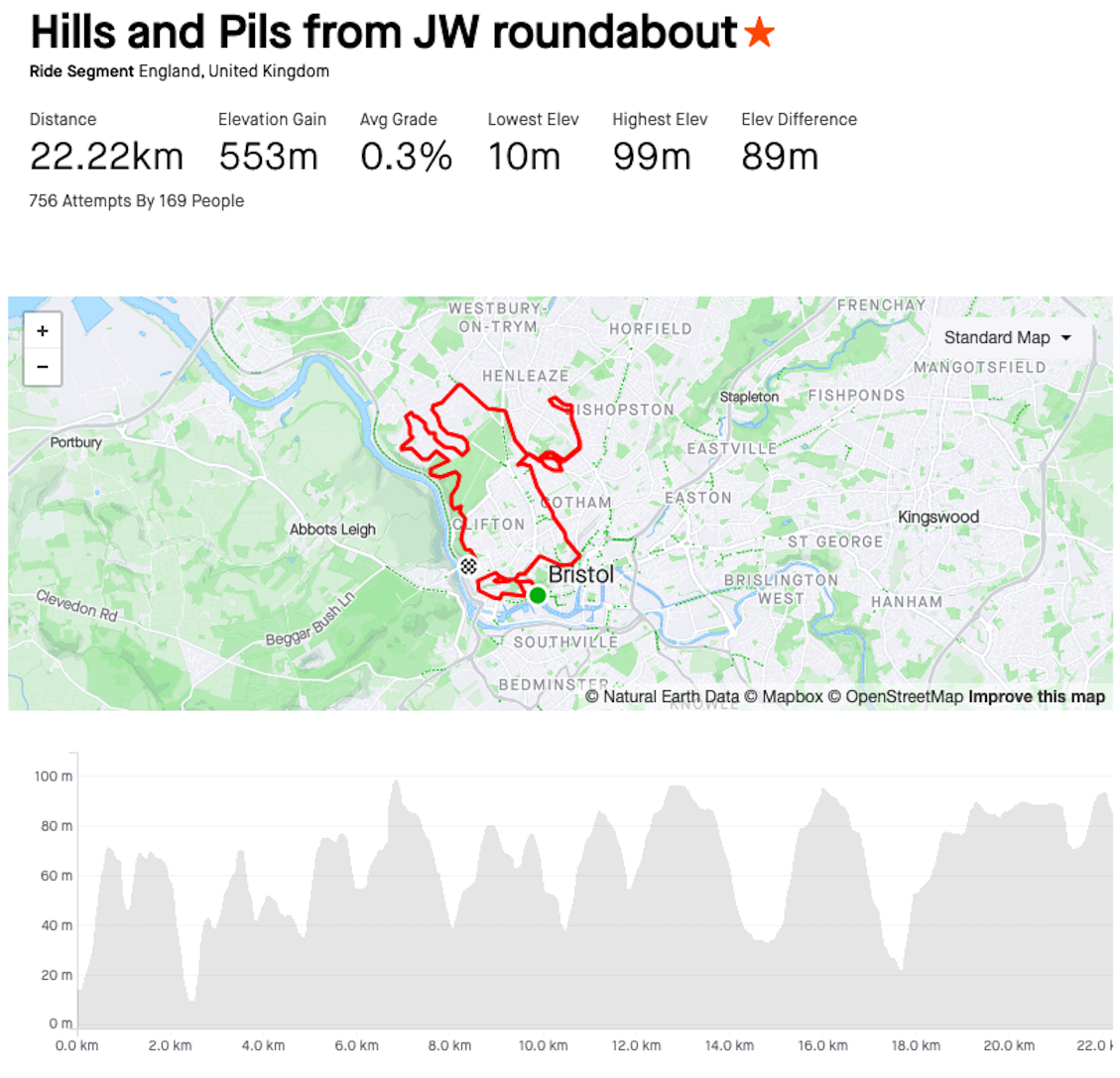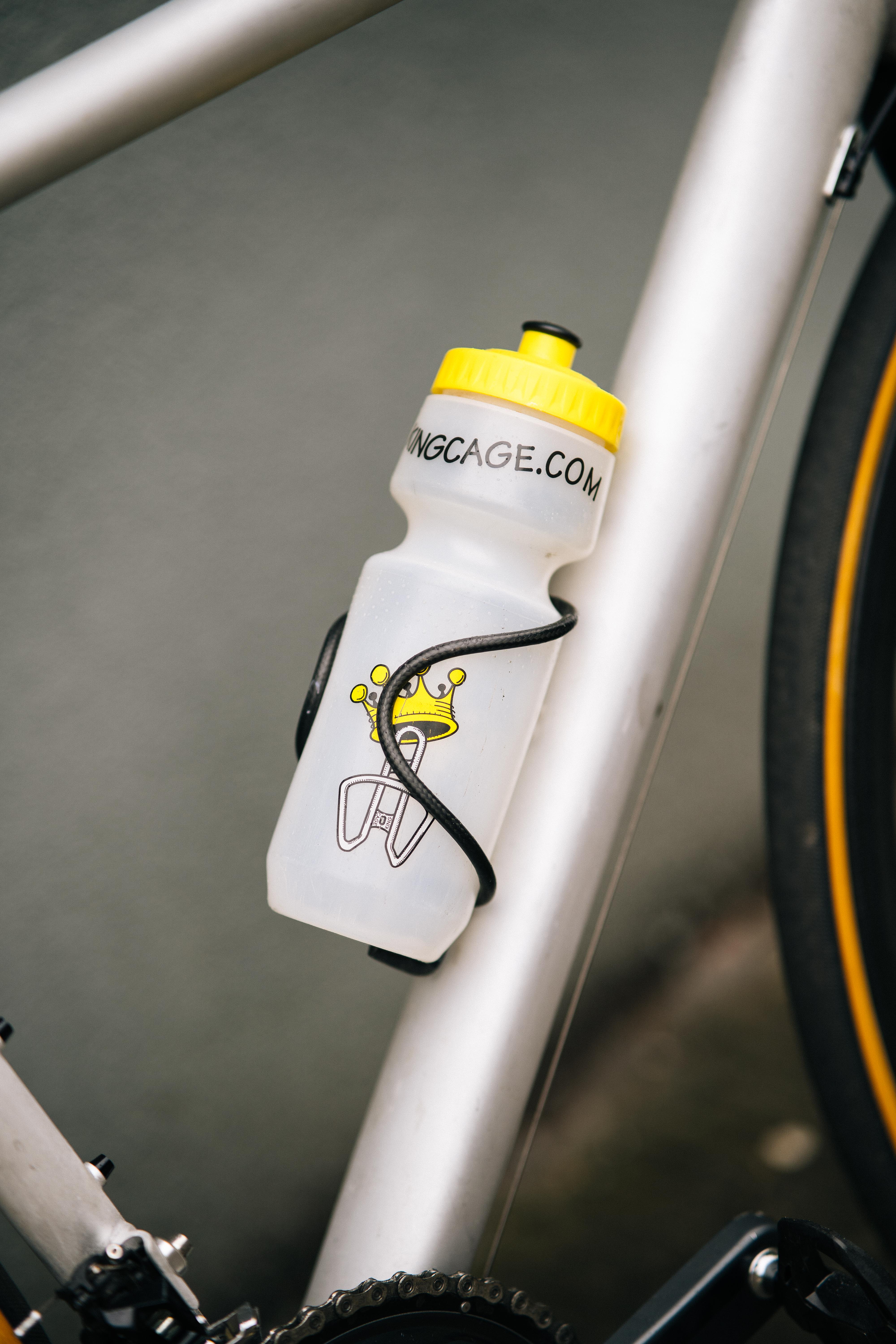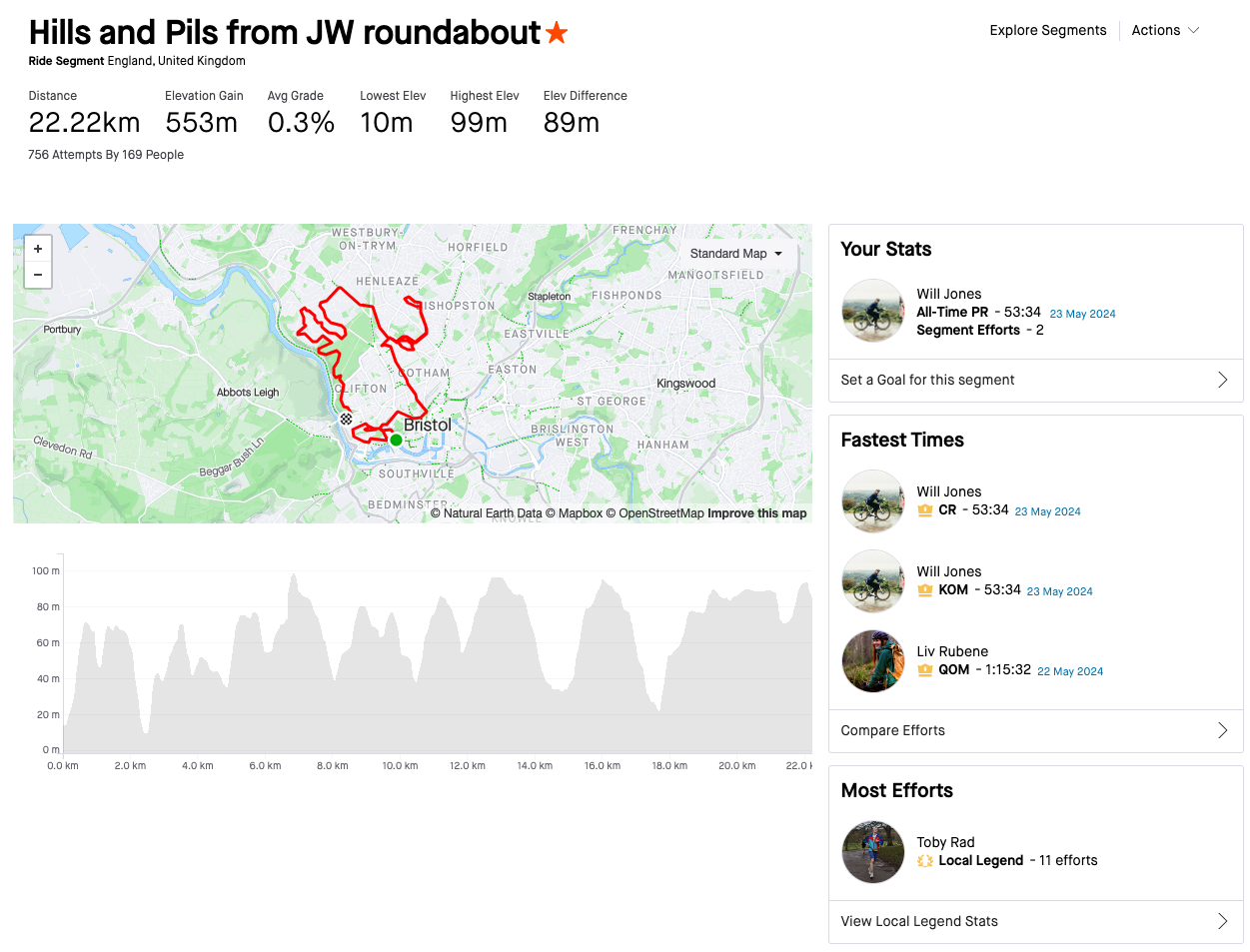
One of the great privileges of this job is, within reason, access to more or less anything the bike industry can produce. I’ve seen colleagues create bike builds for events, gravel superbikes or aero missiles, all well-curated and thought out. Until now, primarily because bike events don’t really appeal to me, I’ve not leapt into building specific, but now here we are… I’ve gone and built a hill climb bike with a twist.
My local club, Newtown Park CC, runs its Hills and Pils ride every Wednesday. The route goes up 13 of the nastiest hills that Bristol, a famously hilly place, has to offer, all of them short and steep, many hitting 15% and some approaching 20%. In 22.2km the route packs in 553m of elevation gain before it finishes at a brewery (hence the Pils), and the current KOM, for the whole route as one segment, was a smidge under an hour at 54:58. Given I have a background in cyclocross, the opportunity to make my eyes pop for an hour in a new way was too good to pass up.
It must be said that going for the KOM is very much against the ethos of the club, which prides itself on being non-competitive, and the done thing on the ride itself is to wait at the top of every hill for the last rider in the group, and roll together to the foot of the next one before any smashing takes place. As such, I did it alone on a Thursday.
While I do like the thought of giving other riders the impetus to go after the KOM (or maybe FKT, though it’s perhaps a bit short for that), it’s a route that takes place in an inner city environment with plenty of traffic lights and junctions so… don’t try this at home. And so to the bike…


A hill climb bike with a twist
Before being overhauled in a big way, my Hills and Pils bike, for that is now what it is called, was a relatively normal Bowman Palace:R. A fun, but pretty run-of-the-mill rim brake alloy frameset that I bought primarily because it had a threaded bottom bracket and external cables. It served me well, but was tired in many ways. I’d always fancied a flat bar road bike, mostly for vibe reasons rather than anything performance-oriented, and so initially I just wanted to do a flat bar conversion and leave it at that.
The paint was knackered, so once the parts had all been removed I rode it up to an old motorcycle workshop and paid a man to give it a nice hot bath in acid, resulting in this lovely matte silver finish.
I’ve already put together a pretty comprehensive guide to making your road bike into a flat bar machine, but the short story was new shifters, a set of Paul brake levers (for the bling factor) that I had in a box, a 150mm Zipp stem and some PRO Koryak bars. Initially, I kept my standard road wheels on, and used the same Thomson seatpost as I had used for years, but these got upgraded presently.

A very noodly ride
One thing I really noticed initially was the huge increase in perceived flex that came from swapping to flat bars. Initially, the bars themselves were 720mm wide, and while the additional leverage was great on the steep hills the setup imparted a huge amount of torsion on the frame while seated. So wobbly did it feel that I even stopped halfway around the route on a test ride one evening to check the frame wasn’t cracked.
After that, I had to reduce the leverage, chopping the bars down to a more reasonable 660mm, which helped a huge amount. It still feels flexible at times, but it’s no longer enough to actually scare me.

Weight weenieism, within reason
It would have been possible to go overboard here and just try and make it the lightest bike possible, but I wanted to keep it usable. Hill climb bikes are often amazing at going uphill, but this one had to be able to go down too, and on the flat for some sections, so 1x was out for starters. The old Ultegra 6800 didn’t have anything wrong with it, and 52/36 and 11-28 was about right that the lowest gear was still reasonably fast, with plenty of beans for any downhills. There are a couple of hills where, if you get the momentum and traffic lights right, you can tackle them in the big ring and gain a load of time, so another reason not to go 1x.

The wheels were the first big swap. While the alloy set built for me by Ryan from RyanBuildsWheels was perfect for generally bashing about, there’s no denying that the Hunt 36 Carbon Wide Aero wheels were lighter, whilst still not being so outlandish and boutique that I’d be scared to hit one of the innumerable potholes that litter Bristol’s streets.

Thomson seatposts are cool, but they don’t half weigh a lot. Something I’d always been curious to try was an unpadded saddle, and so I reached out to Slovenian boutique carbon outfit Bjørn, and borrowed a Sedlo saddle and Glagol seatpost. Yes, this goes against what I said about the wheels, but this is less likely to crack when faced with a pothole. I’d used the saddle shape before when I tested a fully custom titanium Sturdy, and while the cutout was great, it was the ramp at the back that appealed. A lot of the climbs are best tackled out of the saddle, but some are on the limit of what’s doable seated, and when that happens the rear lip stops me sliding off the rear, especially with a greater nose-down tilt than I would ordinarily run.
The only other concession to weight weenieism was the 12-gram Topeak Feza G12 bottle cage. It’s very light, looks cool, but is also incredibly secure. When it came to actually taking on the segment I rarely found myself drinking though, so I could easily have jettisonned it entirely along with the bottle and saved a good 500g. Hindsight is 20:20.
I could easily have swapped the Paul levers out too, given they weigh a tonne each, but to be honest they look so cool I decided it wasn’t worth it. The total weight was 7.6kg, including pedals, cage, computer, saddlebag, and empty water bottle. Not superlight, but for a relatively cheap alloy bike it's not half bad either.

A pedal dilemma
Initially I built the bike up with a set of Crank Brothers eggbeater pedals, not because I ever planned on unclipping and reclipping with ease, or for any weight considerations, but because the bike would almost exclusively be used on rides that finished at a brewery, and walking around in gravel shoes is a lot easier. For the segment though I swapped these out for road pedals. It’s minor, but the stability feels better, especially in my road shoes.

A tyre conundrum
So far this bike has had three sets of tyres, and will soon have a fourth. Initially I fit up the Hunt wheels with Michelin Power Cups, my favourite budget tyre, but the rim and tyre combo didn’t play so well together and the tyres stubbornly refused to seat properly even with tubes. Off they came, and on went a set of Vittoria Corsa N.Ext. Same tread as the Corsa Pro, but in a vulcanised rubber casing to ward off punctures a bit.
These will probably get re-fitted in due course and set up tubeless to actually fight off punctures, but for the segment run itself I threw caution to the wind and slapped on a fresh set of 28c S-Works Turbo Cotton Hell of the North tyres with latex tubes in them. It’s such an easy win in terms of performance it seemed daft not to, and the segment is on my doorstep so I figured if I flatted I could just try again the next day.

A few final details
While I tended to use a Hammerhead as my main computer, I had recently fried it using a duff charger. Fortunately, I also have a wee little Wahoo Bolt too, which was perfect. I knew the route pretty well, but never being one for riding to power, I simply ran it with the map on the screen along with the total time and average speed, with the targets I needed to hit for these metrics taped to the massive stem for reference.
One thing I did swap that was a surprisingly great upgrade was the brake cables. Since feeling the lever feel of my colleague Tom’s Cannondale SuperSix before he embarked on the Paris-Roubaix sportive, I have been chasing a similar setup for my rim brake bikes. Shimano no longer makes its highest quality, polymer-coated cables with MTB ends as the MTB world has long since gone hydraulic and disc brake, so instead I opted for Jagwire road link outers combined with Jagwire MTB inners.
It’s not quite as smooth, but it saved a few grams and the lever feel is vastly better than it was with the cheap housing that was on before. You’d be amazed how much more confidence you have in the brakes when the lever feedback is pleasant; especially important on steep, twisty inner city descents.

A proper spares kit
While I was prepared to risk a flat, I was not prepared to then walk home, so still ran a proper saddlebag complete with spare butyl tube, big tyre levers, a small multi-tool, and a diminutive Birzman Apogee mini pump.
All enough to get me home and live to fight another day. I’ve taken to securing it with an additional Voile Nano strap, as I find it stops any rattling that may occur. Worth the handful of grams in my view.


No aero bars
Something I toyed with in testing was a set of mini Sirocco clip-on aero bars from Controltech. They did allow me to get into a more aero position, but in testing, I found the times when I actually had the opportunity to get into them for any length of time were minimal. There’s one flat section at the end of the route around an area of parkland, but in actuality, I could more or less replicate the position they offered by just holding the bars by the stem and dropping my elbows a bit lower.

A very fast pair of socks
My clothing could have been more optimal, but it was cold when I gave it a crack so a non-aero long-sleeve jersey went on. I had recently been sent what were claimed to be the fastest socks in the world from Sockeloen, at times apparently used by Mathieu van der Poel, so I slapped these on, but that was it.

Well, did you get it?
Yes, just. The route is front-loaded pretty heavily, so it was only in the final 15 minutes or so that I thought I’d make it. In reality, it was more of an excuse to tinker and transform a bike as completely as possible, but it was certainly satisfying to find the mods had paid off. I can’t quite shake the feeling that a relatively decent road bike with disc brakes would probably be faster, but it wouldn’t be nearly so fun, and it certainly wouldn’t have been as cheap, and it’s kept an old bike going which is always good.
I would love someone else to go after it, and there are stronger riders than myself in the club who could easily do it, but to go any faster myself would probably take some unsafe riding, which isn't worth the associated risks.
I might try and continue to optimise the bike more, perhaps with some carbon chainrings, maybe some ultralight wheels, but to be honest I think I’ll actually slap some more sturdy tubeless tyres on it and leave it as a wicked fast pub bike.
Also, I should shout out my clubmate Liv who took the QOM the day before and basically made me decide to go for it the next day.







